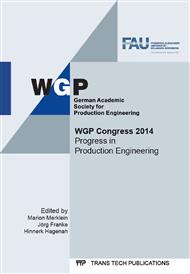[1]
H. Saiki, Y. Marumo, A. Minami, T. Sonoi, Effect of the surface structure on the resistance to plastic deformation of hot forging tools, J. Mat. Proc. Tech. 113 (2001) 22–27.
DOI: 10.1016/s0924-0136(01)00632-x
Google Scholar
[2]
D.J. Jeong, D.J. Kim, J.H. Kim, B.M. Kim, T.A. Dean, Effects of surface treatments and lubricants for warm forging die life, J. Mat. Proc. Tech. 113 (2001) 544–550.
DOI: 10.1016/s0924-0136(01)00693-8
Google Scholar
[3]
M. Shirgoakar, Technology to improve competitiveness in warm and hot forging- increasing die life and material utilization, Dissertation, The Ohio State University, (2008).
Google Scholar
[4]
S. Walter, Beitrag zu den Werkstoffversagensmechanismen beim Gesenkschmieden, Dissertation, Universität Hannover, VDI Verlag, (1999).
Google Scholar
[5]
H. Luig, T. Bobke, P. Groche, Funktion gegen Verlust und Verschleiß, Technische Rundschau (1990) 42–50.
Google Scholar
[6]
D. Caliskanoglu, I. Siller, R. Ebner, H. Leitner, F. Jeglitsch, W. Waldhauser, Thermal fatigue and softening behaviour of hot work tool steels, ICT Conference (2002) 1 591–601.
DOI: 10.1051/jp4:2004120074
Google Scholar
[7]
T. Bobke, Randschichtphänomene bei Verschleißvorgängen an Gesenkschmiedewerkzeugen, Dissertation, Universität Hannover, Düsseldorf, VDI Verlag, (1991).
Google Scholar
[8]
H. Haferkamp, F. -W. Bach, C. Baar, E. Doege, C. Romanowski, Reibung und Verschleiß beim Schmieden, in Fortschritte in der Werkzeugtechnik, Schmieden-Blechumformung-Organisation. E. Doege, D. Besdo, H. Haferkamp, H.K. Tönshoff, H. -P. Wiendahl, (Eds. ), Verlag Meisenbach , 1995, p.43.
Google Scholar
[9]
F. -W. Bach, T. Bobke, E. Doege, D. Linse, Gefügereaktionen und Verschleiß der Randzone von Schmiedegesenken und ihre Beeinflussung durch Plasmaoberflächenbehandlungen, UKH, Hannover, 14. -15. 03. 1990, 13/1-13.
Google Scholar
[10]
E. Doege, T. Bobke, K. Peters, Fortschritt der Randzonenschädigung in Schmiedegesenken, Stahl und Eisen, 111 (1991) 113–118.
Google Scholar
[11]
A. Weroński, T. Hejwowski, Thermal fatigue of metals, 74, New York, M. Dekker, (1991).
Google Scholar
[12]
C. Agelet de Sarcibar, M. Chiumenti, On the numerical modeling of frictional wear phenomena computer methods in applied mechanics and engineering, 177 (1999) 401–426.
DOI: 10.1016/s0045-7825(98)00390-9
Google Scholar
[13]
R. Melching, Verschleiss, Reibung und Schmierung beim Gesenkschmieden, Dissertation, Universität Hannover, (1980).
Google Scholar
[14]
J.F. Archard, Wear Theory and Mechanism, in Wear control hand-book, Peterson, M., Winer, W.O. (Eds. ), New York (1980) p.35–80.
Google Scholar
[15]
T. Sobis, U. Engel, M. Geiger, A Theoretical Study on Wear Simulation in Metal Forming Processes, J. Mat. Proc. Tech. (1992) 233–240.
DOI: 10.1016/0924-0136(92)90112-6
Google Scholar
[16]
S. Andersson, Wear Simulation, in Advanced Knowledge Application in Practice, Fuerstner, I. (Eds. ), 2010, p.15–36.
Google Scholar
[17]
V. Hegadekatte, Kurzenhäuser, N. Huber, O. Kraft, A predictive modeling scheme for wear in tribometers, Trib. Int., 41 (2008) 1020–1031.
DOI: 10.1016/j.triboint.2008.02.020
Google Scholar
[18]
E. Felder, J.L. Montagut, Friction and wear during the hot forging of steels, Trib. Int., 13 (1980) 61–68.
DOI: 10.1016/0301-679x(80)90011-0
Google Scholar
[19]
J.H. Kang, I.W. Park, J. Jae, S. Kang, A study on die wear model of warm and hot forgings Metals and Materials 1 (1998) 477–483.
DOI: 10.1007/bf03187813
Google Scholar
[20]
B. -A. Behrens, F. Schäfer, Prediction of wear in hot forging tools by means of finite-element-analysis, J. Mat. Proc. Tech. (2005) 309–315.
DOI: 10.1016/j.jmatprotec.2005.06.057
Google Scholar


